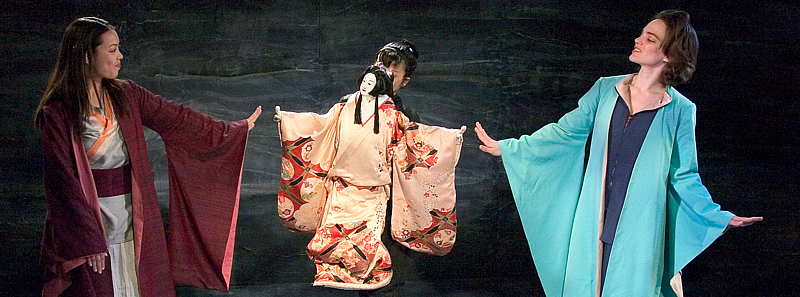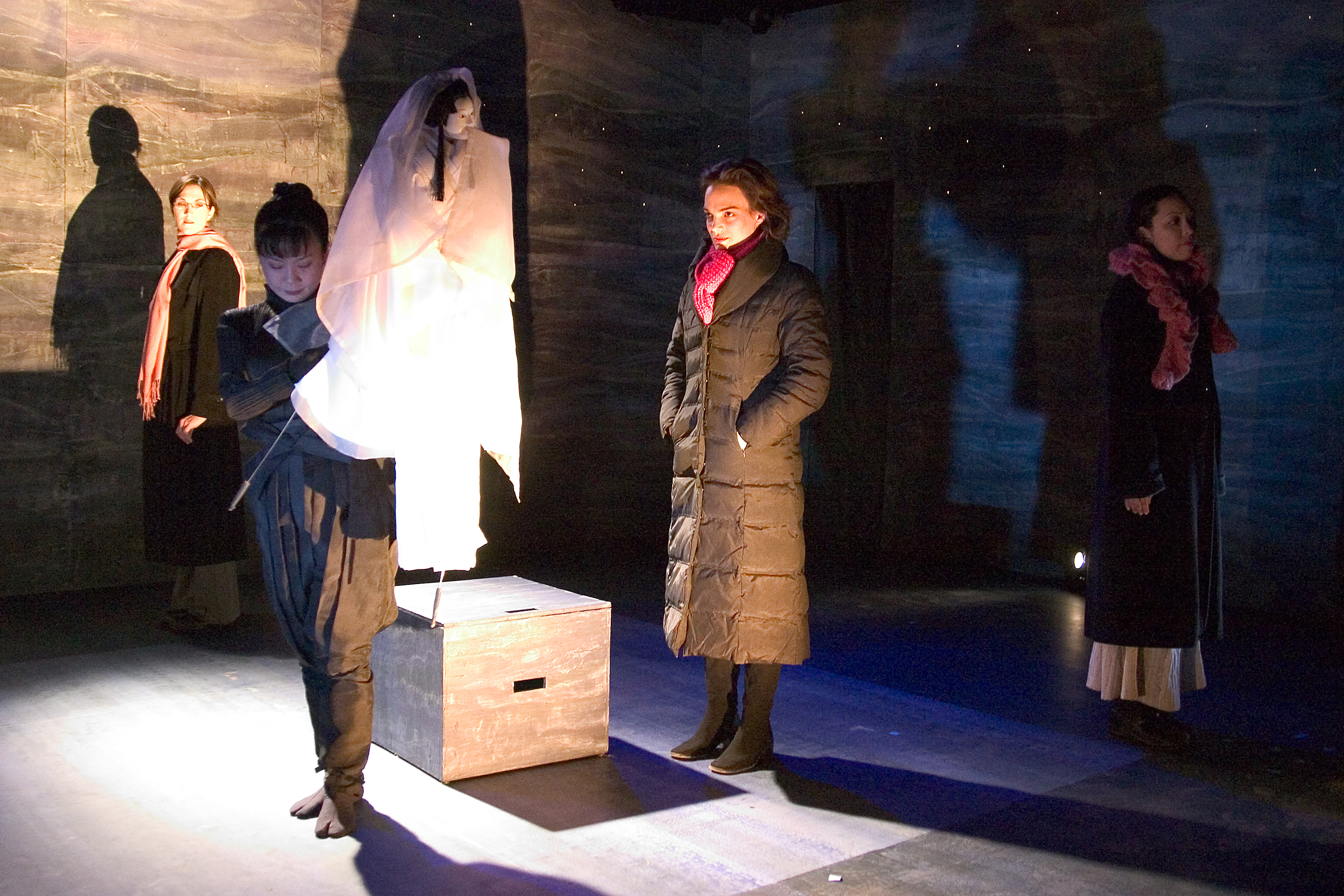Thousand Years Waiting (2006)
By Chiori Miyagawa
Directed by Sonoko Kawahara

Performance Space 122
The puppet, created and performed by Masaya Kiritake, is quite beautiful. Ms. Skiles has an expressive face and a lovely, melodic voice. Under the direction and choreography of Sonoko Kawahara, she, like the other performers, acquits herself with grace and precision.—New York Times
The piece itself has lightness and movement—Ms. Miyagawa pokes gentle fun at The Tale of Genji and its womanizing, oblivious hero. In Sophia Skiles…the production finds a warm and sympathetic center. —The New York Sun
Both director Sonoko Kawahara’s stylized choreography and eclectic music reflect the juxtaposition of old and new, and some sequences using an elegant Otome Bunraku puppet against a starry backdrop are pure magic. —Time Out NY
Thousand Years Waiting, a collaboration by theatre artists. is a work of singular beauty and inspiration. I’ve never seen anything quite like it, at least in part for the very good reason that Kiritake is one of the world’s only practitioners of the art of Otome Bunraku.—nytheatre.com
About the production
Thousand Years Waiting was a historic theatrical moment in New York City. The production marked the first collaboration between American theater artists and an Otome Bunraku puppeteer. Playwright Chiori Miyagawa and composer Bruce Odland developed the world of the play with layers of different realties in text and music first. When director Sonoko Kawahara joined the creative team, she brought in Masaya Kiritake, the Otome Bunraku puppeteer from Japan, adding a visual testimony to the essence of being women, manifested in the stunningly beautiful, traditional dolls. This was the first time that a traditional Otome Bunraku puppeteer performed with American actors in a contemporary American play.
About the play
Thousand Years Waiting is a new play with three simultaneous realities: present-day New York City, Japan circa 1000, and inside The Tale of Genji—the world’s first novel. The history of storytelling is woven like a spider’s web, and the woman in the present steps in and out of real and fictional worlds in the past. An Otome Bunraku puppet (a rare art form originating in 17th-century traditional Japanese puppetry) played the role of a timeless spirit with an ethnically diverse group of American actors.
GALLERY
Photography by David Altman
About the Otome Bunraku
Otome Bunraku is an early twentieth-century offshoot of the 17th-century Bunraku Puppet Theater. This form emerged because women were not allowed to perform the traditional form. In Otome (female) Bunraku, a single woman performer dances with a four-foot puppet, instead of Bunraku’s traditionally sanctioned three-man method of operation. The result is a more sensual and intimate movement of the puppet. Today Otome Bunraku is a near-extinct art form; only three women in the world perform it professionally.
This unique collaboration among three key women artists—a Japanese-American playwright, an expatriate Japanese director, and a traditional artist Maskaya Kiritake from Japan made theatrical history with Thousand Years Waiting.
Costumes for Thousand Years Waiting
Ms. Masaya Kiritake created a historically accurate puppet in silk kimono especially for this performance of Thousand Years Waiting. In keeping with the original seventeenth-century tradition, when a Bunraku performance piece is chosen (in this unique case, a new American play), the puppeteer orders hand-dyed, one-of-a-kind silk from a master fabric designer. The fabric alone costs $5,000. The puppet wears layers of these materials, and the kimonos are hand sewn by the puppeteer. The authenticity of the puppets is critical to the integrity of performance. The artist takes pride in and derives confidence from that authenticity. Properly attired puppets are stunningly beautiful on stage and heighten the theatricality of the play. Thousand Years Waiting was a rare opportunity for the audience to see the genuine Japanese Bunraku doll.
The American actors in the production wore costumes that represent different times and locations. The woman in the present time New York City was dressed in casual western clothes. The actors who stay in the year 1000 in Japan wore original and imaginative representations of kimonos, designed by Theresa Squire.
Music for Thousand Years Waiting
“Time Tunnels” composed by Bruce Odland
The instruments used in the music were a combination of ancient and new, coming from the Field Museum’s Ethnographic collections and the Denver Art Museum’s Pre-Columbian collection. Within the same cut, there may be a blend of a monk’s shakuhachi, Karen bronze drum (encoding the clan’s history and cosmology in a thin bronze drum head), Peruvian ocarina (for summoning the dead), Nigerian drum (for communicating with ancestors), and a prayer bell from India. The music for Thousand Years Waiting traversed generations, borders, time, and space.
Artists for the production
Playwright: Chiori Miyagawa
Director: Sonoko Kawahara
Composer: Bruce Odland
Otome Bunraku Puppeteer: Masaya Kiritake
Performance by: Margi Douglas, Sophia Skiles, Anna Wilson & Masaya Kiritake
Dramaturgy: Debra Cardona
Set design: Donyale Werle
Costume design: Theresa Squire
Lighting design: Rie Ono
Sound: Nicholas Emmet & Mark McNamara
Stage Manager: Yoko Ikeda
Associate Producer: Jacob Burstein-Stern
Assistant Director/Associate Producer: Vanessa Bombardieri
Research Assistant: Nanako Nakajima
Koken: Yukako Yamazoe & Fumiko Inoue
February 23-March 12, 2006
This production was supported by: Lower Manhattan Cultural Council, Asian Cultural Council, The Greenwall Foundation, Jim Henson Foundation, Edith Lutyens and Norman Bel Geddes Foundation, Nancy Quinn Fund, Asian American Arts Alliance, Japan Foundation, and All Nippon Airline.






















